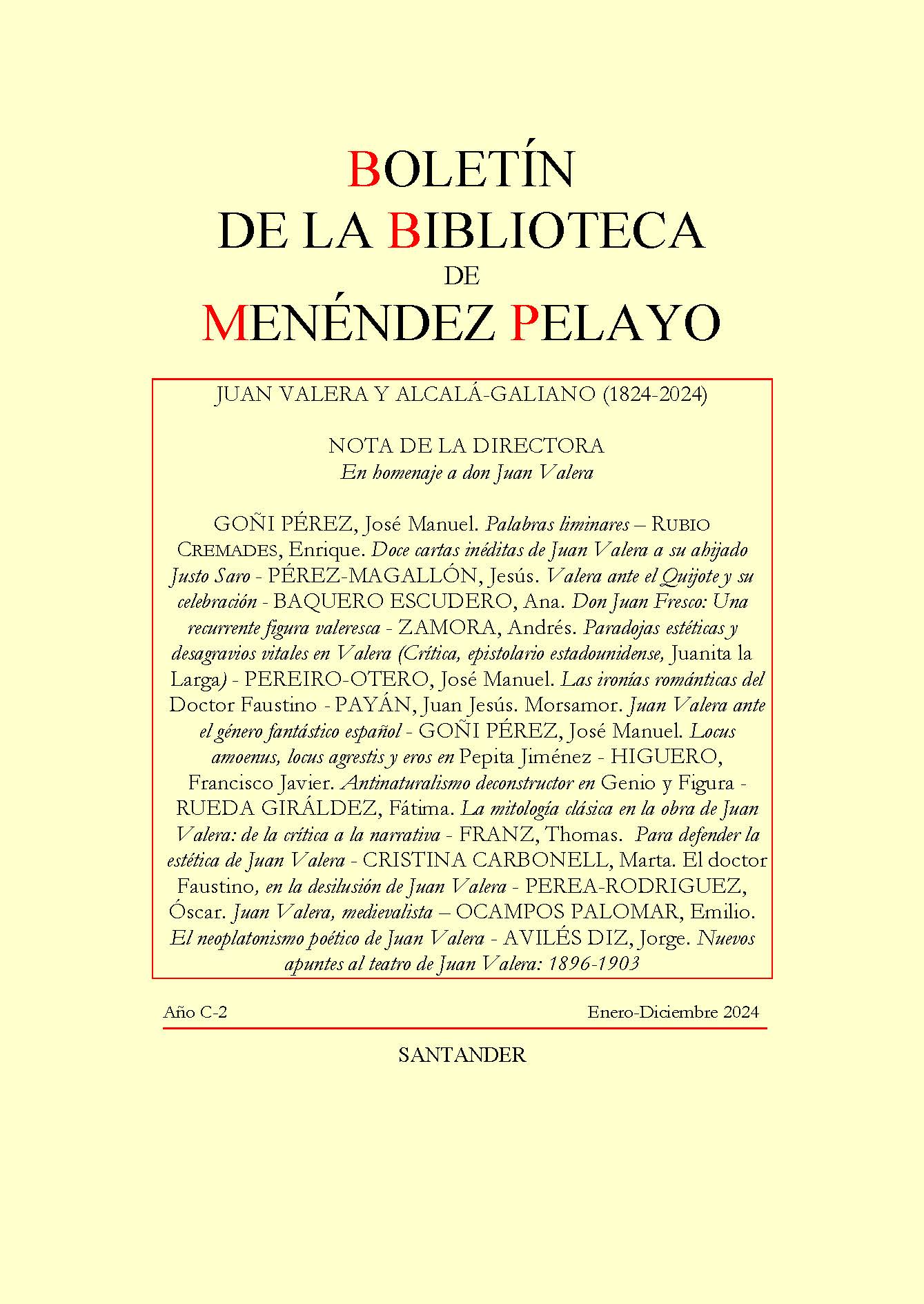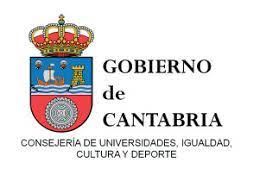To defend the aesthetics of Juan Valera
DOI:
https://doi.org/10.55422/bbmp.987Keywords:
Juan Valera, Idealism, Illustration of an invisible world, Intimacy, Order, Communicability of a synthetic visionAbstract
From the crowning period of Realism-Naturalism to the activism of today the Idealism of Juan Valera has been subjected to harsh criticism. Nevertheless, his intimate portraits and creation of orderly beauty are based not only on solid philosophical principles but also on a profound undergirding vision that his age often obliges him to obscure.
Downloads
Publication Facts
Reviewer profiles N/A
Author statements
Indexed in
- Academic society
- Sociedad Menéndez Pelayo
- Publisher
- Sociedad Menéndez Pelayo
Global Statistics ℹ️
|
151
Views
|
93
Downloads
|
|
244
Total
|
|
References
ALTENBERND JOHNSON, Patricia. (2000). On Heidegger. Belmont, California. Wadsworth.
AMORÓS, Andrés. (2005). La obra literaria de Juan Valera: La “música de la vida”. Madrid. Castalia.
AZORÍN. (1959). De Valera a Miró. Madrid. Afrodisio Aguado.
BETTELHEIM, Bruno. (1977). The Uses of Enchantment: The Meaning and Importance of Fairy Tales. Nueva York. Knopf. DOI: https://doi.org/10.3817/0677032215
BIANCHINI, Andreina. (1990). «Pepita Jiménez, Ideology and Realism». Hispanófila. 33. 2. 33-51.
CIALLELLA, Louise. (2007). Quixotic Modernists: Reading Gender in Tristana, Trigo, and Martínez Sierra. Lewisburg. Bucknell University Press.
COLLINS, Christopher. (1991). Reading the Written Image: Verbal Play, Interpretation, and The Roots of Iconophobia. University Park. Pennsylvania State University Press. DOI: https://doi.org/10.1515/9780271071534
DECOSTER, Cyrus. C. (1974). Juan Valera. Nueva York. Twayne.
FERNÁNDEZ, Pura. (2008). Mujer pública y vida privada: del arte eunuco a la novela lupanaria. Londres. Támesis, 2008. DOI: https://doi.org/10.1017/9781846156649
FRANZ, Thomas R. (2006) «Preface», A Translation of Don Juan Valera’s Morsamor, por Robert G. Trimble, Lewiston, Edwin Mellen. 1-4.
FRANZ, Thomas R. (2000). Valera in Dialogue / In Dialogue with Valera: A Novelist’s Work in Conversation with that of His Contempraries and Successors. Berna. Peter Lang.
FREELAND, Cynthia. (2001). But Is It Art? Oxford. Oxford University Press.
FROMM, Erich. (1951). The Forgotten Language: An Introduction to the Understanding of Dreams, Fairy Tales and Myths. Nueva York. Grove.
HEIDEGGER, Martin. (1997). The Origin of the Work of Art. En Basic Writings. Edición aumentada. Editada por David Farrell Krell. Londres. Harper. 139-212.
KAMINSKY, Jack. (1962). Hegel on Art: An Interpretation of Hegel’s Aesthetics. Nueva York.State University of New York. DOI: https://doi.org/10.2307/jj.18252132
KANT, Immanuel (1940). Critique of Judgment. En Kant. Edición de Julien Benda. Londres. Longmans, Green. 170-188.
KNOWLTON, John. (1969). «The Hippolytus Myth in Pepita Jiménez». Romance Notes. 11. 73-75
LÓPEZ, Ignacio Javier. (2011). «Detalle del manuscrito». Gloria, por Benito Pérez Galdós. Madrid. Cátedra. 153-154.
MONTESINOS, José F. (1957). Valera o la ficción libre. Madrid. Gredos.
PAOLINI, Gilberto. (1983). «Interacción del mundo artístico y psicológico en Doña Luz de Juan Valera». Anales de la Literatura Española. 2. 409-417. DOI: https://doi.org/10.14198/ALEUA.1983.2.18
PÉREZ GALDÓS, Benito (1990). Ensayos de crítica literaria. Edición de Laureano Bonet. Barcelona. Ediciones Península.
POWER, Arthur. (1974). Conversations with James Joyce. Millington. Londres.
RODRÍGUEZ, Rodney T. (1985). «Icarus Reborn: Mythical Patterns in Pepita Jiménez». Revista de Estudios Hispánicos. 19. 3. 75-85.
RUPE, Carole J. (1986). La dialéctica del amor en la narrativa de Juan Valera. Madrid. Pliegos.
RUSSELL, Bertrand. (1959). The Problems of Philosophy. Oxford University Press.
SÁNCHEZ GARCÍA, Remedios. (2013). «Nosce Te Ipsum: Principios filosóficos en la construcción novelística de Las ilusiones del doctor Faustino y El Comendador Mendoza de Juan Valera». Hispania. 96. 3. 493-504. DOI: https://doi.org/10.1353/hpn.2013.0079
SIMÓN, Ana Iris. (2021). Feria. Madrid. Círculo de Tiza
SOBEJANO, Gonzalo. (1968). «Valle-Inclán frente al realismo». Ramón del Valle-Inclán: An Appraisal of His Life and Works. Nueva York. Las Américas. 159-171.
SOTELO VÁZQUEZ, Adolfo. (2005). «Ramón Pérez de Ayala frente a JuanValera». Cuadernos Hispanoamericanos. 665. 7-16.
THURSTON-GRISWOLD, Henry. (1990). El idealismo sintético de Juan Valera. Potomac, Maryland. Scripta Humanistica.
TRIMBLE, Robert G. (2007). «Introducción» a A Translation of Don Juan Valera’s Morsamor, traducido por Robert G. Trimble. Edwin Mellen. xi-xv.
VALERA, Juan. (1961). Obras Completas. Editadas por Luis Araujo Costa. 3.a ed. Madrid. Aguilar.
VARELA IGLESIAS, M. Fernando. (1986-1987). «El escepticismo filosófico de don Juan Valera». Anales de la Literatura Española. 5. 27. 533-556. DOI: https://doi.org/10.14198/ALEUA.1986-1987.5.27
Downloads
Published
How to Cite
Issue
Section
License

This work is licensed under a Creative Commons Attribution-NonCommercial 4.0 International License.







